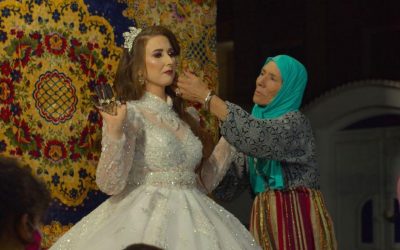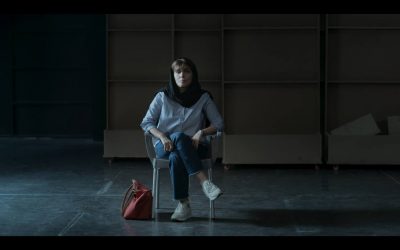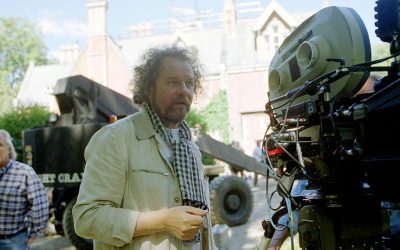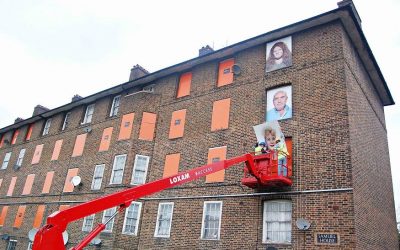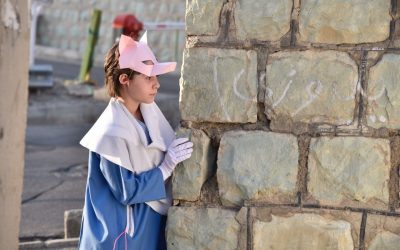Markéta Jakešová & Mania Akbari
This selection of seven films by young Iranian women filmmakers explores the fragile and shifting nature of contemporary existence through their unique perspectives. With intimate narratives and striking visuals, these works illuminate the dreams, fears, and resilience of a generation navigating profound uncertainty while daring to envision alternative futures. Together, they form a mosaic of voices—revealing both the fractures of the present and the sparks of creativity that light the path forward. Offering a poetic and philosophical reflection, this collection invites us to consider what it means to dream in an unstable world. (Written by Mania Akbari)
Maryam Bakhtiari: Falling Up (2022)
“Would you like to turn the universe plain and smooth? This is the universe – how could it ever be plain and smooth?” A verse by Abu Abdollāh Rudaki opens the short film Falling Up (2022), the directorial debut of Maryam Bakhtiari. Set in a future where dreams can be ordered, the story follows a man reliving a cherished memory and a woman—played by Bakhtiari herself—pushing the limits of what dreams can achieve. A mistake intertwines their paths, exposing the emptiness of unattainable desires and the necessity of confronting life as it is.
While Bakhtiari claims her work avoids explicit political statements, the film subtly critiques censorship, bureaucracy, and the unspoken realities of life in Iran. In the end, the audience witnesses an act of resistance that resonates even more deeply in light of events that unfolded in Iran just months later.
Nona Shahrirari: Let’s Talk About it Tomorrow (2023)
Set against the backdrop of protests echoing “Zan–Zendegi–Azadi!” (Woman–Life–Freedom!), Let’s Talk About It Tomorrow (2023) by Nona Shahrirari explores the intersection of personal and collective struggles. Tina, alone at home, wrestles with stress, turning scissors in her hands as muffled unrest filters through an open window. In a desperate act of defiance, she cuts her hair—a symbolic gesture of protest familiar to many Iranians. The contrast between the chaos outside and the sterile calm of her apartment underscores her isolation and inner turmoil.
However, Tina and her husband face a weightier decision than symbolic gestures: In a world shaped by systemic oppression, can hope still emerge within the fragile boundaries of our private lives?
Golzar Farzaneh: Interlude (2023)
Interlude (2023) by Golzar Farzaneh is an intimate exploration of invisibility and longing, set in a theater within a film within a film. The title, میانپرده (Miyan-Pardeh), translates to both “interlude” and “between the curtains,” reflecting the main character’s role as an unseen figure tasked with moving the stage curtains. She remains in the shadows—unnoticed, unseen, and told not to watch the performance because her presence distracts the star actress.
Through fragmented visuals and abrupt blackouts, the film captures her fleeting glimpses of the stage and her desire to escape the darkness. “I don’t like being in the dark,” she confesses, a sentiment that shapes the film’s poetic tone. Interlude concludes with a surreal enactment of her dream—or perhaps someone else’s fantasy: “Cut! Thanks. We’re done.”
Mahdokht Molaei: Homa (2023)
“I loved you. All these years, you’ve been the dearest person in my life. But I can’t do this anymore,” says a woman’s voice over a black screen. In Homa (2023), Mahdokht Molaei crafts an intimate mother-daughter drama set entirely in a car—a tradition in Iranian cinema that offers naturalism while navigating the constraints of mandatory hijab on screen.
Through emotive dialogue, the film unpacks a difficult family history: a marriage that cast a shadow on the daughter’s childhood, interwoven with present challenges and hopes for the future. Despite its serious themes and lyrical tone, the film embraces moments of subtle humor. Ending with a tender, handheld-shot moment of solidarity, Homa explores women’s resilience in a deeply patriarchal society, where generations of struggle find fleeting moments of warmth and connection.
Shadi Karamroudi: All The Time (2020)
All The Time All The Time (2020), directed by actress and filmmaker Shadi Karamroudi, opens with a troubling revelation: Toranj (played by Karamroudi herself) learns that her younger sister Tara may be planning to jump from the roof after her birthday party. At first, Toranj brushes it off and continues her day, but the weight of the revelation intensifies as the film progresses.
Set against the backdrop of Toranj’s growing unease, the film’s original title, هرگز، گاهی، همیشه (Never, Sometimes, Always),reflects the introspection she undergoes throughout the day. In the film’s second half, Toranj’s hesitant efforts to confront her sister reveal more about her own struggles and inner turmoil.
As Karamroudi explains, the film is less about Tara’s potential actions and more about Toranj’s journey to take them seriously, offering an intimate portrait of familial bonds, unspoken fears, and the complexities of human connection.
Roya Parsa: Airless (2023)
Airless (2023), directed by actress and filmmaker Roya Parsa, opens with a woman’s voice reflecting on unfulfilled dreams and the fragility of life. The serene imagery gives way to Bahareh’s uneasy reality: a road trip with her husband that reveals the weariness and unspoken tensions in their relationship.
As diegetic music from the car radio dissolves into a haunting classical score, Bahareh’s introspection deepens. The couple’s shared history of unfulfilled hopes and illness comes to the surface, culminating in a tragic moment that blurs the boundary between fantasy and reality.
In its stark and devastating conclusion, Airless explores despair, the growing distance between two people, and the bleak yet inevitable search for closure. Parsa crafts a haunting meditation on the weight of personal and shared struggles, set against the background of a stifling journey.
Sonia Sanjari: A Long Walk (2023)
The most experimental film of the selection, A Long Walk (2023) by Sonia Sanjari draws inspiration from dreams, blending disorienting visuals with a surrealist tone. The story begins with a motorbike crash and timelines colliding as Mona, the protagonist, struggles with grief after the death of her partner, Saeed.
Mona’s introspection deepens as she becomes isolated from the world around her, resistant to both external connection and personal healing. “I don’t want to be strong,” she confesses, capturing the film’s central theme: strength is not always the answer—resilience and the courage to start over are.
Sanjari describes her film as a meditation on healing, with Mona threading an unknown path forward, integrating sorrow into her sense of self. A Long Walk offers a moving and surreal meditation on loss, healing, and the resilience needed to move forward.
Conclusion: Resilience And Healing
This collection of seven films showcases the power of cinema to explore the complexities of being a woman within cultural and societal constraints. Through their distinctive visions, these young Iranian women filmmakers navigate themes of loss, resilience, and healing, crafting narratives that are both deeply personal and universally resonant.
From the fragmented dreams of Falling Up, through the relationship challenges of Let’s Talk About It Tomorrow and Airless, the female bonds in Homa and All the Time, to the meditative introspection of Interlude and A Long Walk, each film reflects the interplay between inner struggles and external forces. More than stories, these works are acts of courage and imagination, confronting pain and uncertainty with honesty while reminding us of art’s enduring power to inspire hope and transformation.


